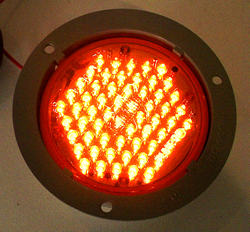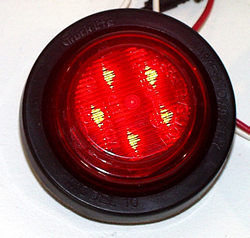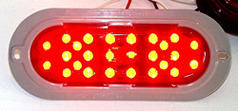The Long and Lighted Road: Lighting and Driving
Brake and Turn Signals
Automotive Signal Lights
More than half of all traffic accidents involving two automobiles occur when both vehicles are traveling in the same direction. Because of this, brake lights and turn signals began to appear on vehicles as early as 1906. For most of the time since then, tungsten filament lamps have been used as the main light source in vehicular signaling. However, the development of alternative sources for brake and turn signals has grown during the last ten to twenty years, and more and more automobiles are using light emitting diode (LED) or neon light sources in automotive signals.
 |
 |
 |
|
Light emitting diodes (LEDs) are being used increasingly for automotive signals. |
|
High brightness LEDs using aluminum gallium indium phosphate (AlGaInP) substrates have made applications for LEDs possible that formerly were not feasible because LEDs simply had not been bright enough to be useful signals during daytime viewing conditions. Full sunlight on a clear day can approach 10,000 footcandles (100,000 lux), so signals on vehicles must be bright enough to be seen against bright backgrounds! (for more on LEDs, see Lighting Futures, Volume 3, Number 4, "LEDs: From Indicators to Illumination?" at www.lrc.rpi.edu/programs/futures/lf-leds.)
 |
Center high-mounted stop lights are currently required on all automobiles; older vehicles can be outfitted with retrofit units such as this one. |
Neon is another light source which has seen increased use in automotive signalling applications, because of its durability, color, and ability to be formed into different shapes (styling). Requirements are now in place stating that all vehicles must be equipped with an additional, center high mounted stop light (CHMSL) in addition to the traditional brake lights at the rear of the vehicle. Both neon lamps and LEDs can be used in ways that appear dramatically different from conventional tungsten filament sources, and more and more vehicles will use these lamps in the future. These technologies have given automotive designers additional tools in their quest for sleek, attractive automobiles.
Such use of these alternative sources will impact the energy use profile in vehicles. Consider that a tungsten filament light source may have a luminous efficacy of 15-20 lumens per watt. Filtering this lamp to appear red reduces its efficacy by a fifth or more, with a resulting luminous efficacy of 3-4 lumens per watt. Current red aluminum gallium indium phosphide (AlGaInP) LEDs and neon lamps both exceed filtered incandescent lamps on a luminous efficacy basis, meaning that such signals will use less energy, possibly impacting overall automobile fuel efficiency.
Further reading:
Forbes, T.W. 1972. Human Factors in Highway Traffic Safety Research. New York: Wiley-Interscience.
Introduction | Interior | Headlights | Vehicle Signals | Roadway | Traffic Signals | Links | Credits


